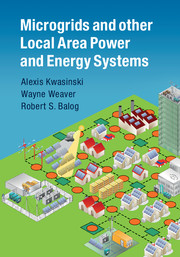8 - Operation and control
from Part III - Integration
Published online by Cambridge University Press: 05 July 2016
Summary
This chapter discusses operation and control aspects related to the system architectures presented in Chapter 7. The basic focus in this chapter is on discussing control strategies that can mitigate stability issues found in systems in which most of the loads have power electronic interfaces that make them operate as CPLs. Another major focus of this chapter is on control systems architecture and methodologies, especially oriented toward autonomous controls. This chapter presents advanced control concepts, including nonlinear and game-theoretic techniques, and concepts related to linear and geometric controllers for converters operation with CPLs.
Autonomous controls of LAPES
Some of the goals in relying on a LAPES for powering loads are to achieve higher power supply availability than from a bulk power grid and to realize more flexible and optimal ways to utilize electric power at a local level. However, the mere use of local distributed generation units does not necessarily imply a local improvement in system availability or efficiency over conventional grids, as it is commonly implied [1]. As explained in Chapter 2, to achieve high availability a system needs to maintain full operation even when one or more failures occur, i.e., it needs to be fault tolerant. One of the main premises in the design of fault-tolerant systems is to avoid single points of failure.
Some of the microgrid architectures currently proposed have a centralized controller that controls the power flow from each source and monitors the overall system condition [2]. This control architecture has several disadvantages, including limited flexibility and high risk of failure due to the presence of a single point of failure in the controller [3]. In some cases, critical components of systems with centralized controllers are designed to maintain the configuration and operational state so the entire system does not fail if the controller fails. However, keeping the system functioning is often achieved at the expense of some operational features, such as energy efficiency. Implementation of other desired operational functions, such as current sharing among source interfaces, may also affect system availability. Current sharing is implemented to balance operational stresses in power sources’ electronic interfaces. In a system with current sharing, source interfaces are controlled so they all have output currents proportional to their power ratings.
- Type
- Chapter
- Information
- Microgrids and other Local Area Power and Energy Systems , pp. 337 - 393Publisher: Cambridge University PressPrint publication year: 2016



